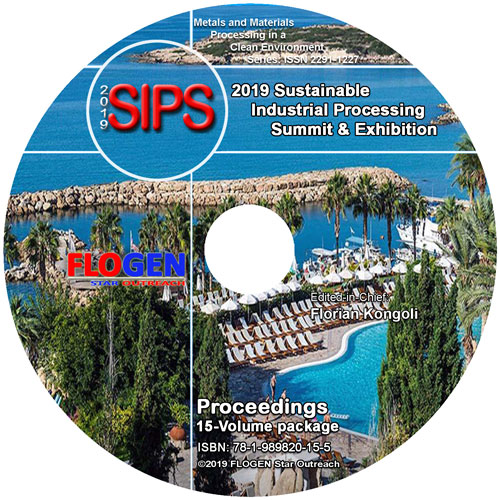2019-Sustainable Industrial Processing Summit
SIPS2019 Volume 8: Usui Intl. Symp. / Advanced Sustainable Iron and Steel Making
| Editors: | F. Kongoli, P. Assis, M.C. Gomez-Marroquin, S. Kitayama, H. Konishi, A. Murao, S. Nomura, H. Ono, H. Saxen, K. Seto, J.I. Tani |
| Publisher: | Flogen Star OUTREACH |
| Publication date: | 20 December 2019 |
| Pages: | 250 pages |
| ISBN: | 978-1-989820-07-0 |
| ISSN: | 2291-1227 (Metals and Materials Processing in a Clean Environment Series) |

CD shopping page
Influence of Basicity on Reduction Rate of Iron Oxide
Hirokazu Konishi1; Tateo Usui2; Hideki Ono3;1OSAKA UNIVERSITY, Suita, Japan; 2OSAKA UNIVERSITY, Ibaraki, Japan; 3UNIVERSITY OF TOYAMA, Toyama, Japan;
Type of Paper: Invited
Id Paper: 273
Topic: 2
Abstract:
Since reducibility of iron oxide in iron ore directly affects the amount of CO2 from BF, the enhancement of reducibility of iron oxide is important to reduce CO2 emissions. The iron ore grade, however, becomes lower year by year. Gangue in iron ore is increasing especially in Al2O3. It is observed that the reducibility of sintered iron oxide pellets decreases with the increase of Al2O3 content in softening and melting zones over 1373 K in BF. Besides, it is reported that the initial melt formation temperature drops and the amount of melt increases with the increase of Al2O3 content [1]. Since molten oxide formed inside sintered iron oxide pellets causes pore occlusion [2], melt formation can affect reducibility in the softening and melting zones. Therefore, it is required to determine the effect of melt on reduction behavior to enhance reducibility of sintered iron oxide pellets.
We focused on the reduction behavior and rate of sintered iron oxide pellets on the initial melt formation stage and investigated the effect of melt on the reducibility of iron oxide. The sample was prepared by sintering a mixture of Fe2O3, CaO, SiO2, and Al2O3 regent powder. Reduction experiments were carried out to clarify the reduction behavior of a sample from 1273 K to 1473 K and to determine the effect of melt on reduction rate of a sample at 1473 K. The microstructure of a sample was observed by a scanning electron microscope (SEM) and porosity was estimated by an image analysis technique.
Keywords:
Blast; CO2; Calcium; Iron; Melting;References:
[1] H. Konishi, H. Kawabata, H. Ono and E. Takeuchi, Advanced Experimental Mechanics, 1(2016), 251.[2] H. Kawabata, Y. Iwaki, H. Konishi, H. Ono, T. Usui, E. Takeuchi, M. Naito, T. Nishimura and K. Higuchi: Journal of JSEM, 16(2016), 20.